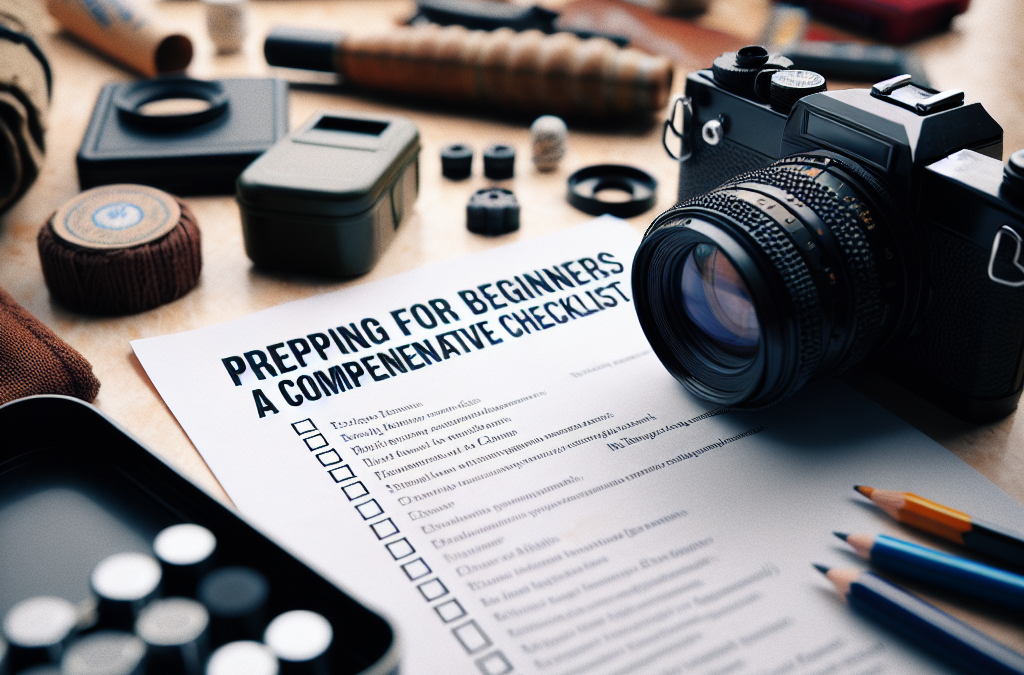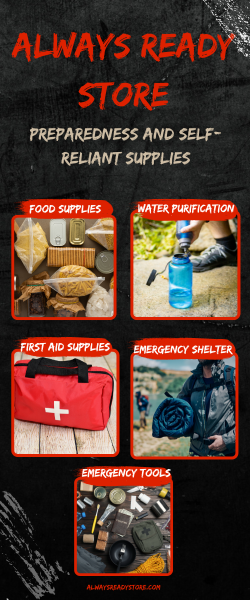Emergency Supplies
Water Storage
When I started prepping, the first thing on my mind was water. It’s literally the most crucial element for survival. I recommend at least one gallon per person per day for a minimum of three days. You can store this in 5-gallon jugs or use water bricks that come in stacks to save space.
Additionally, I found it useful to include purification tablets and filters to make sure that if I ran out, I could still get clean water from natural sources. Always remember, you might be okay without food for a few days, but without water? Not so much!
And don’t forget about pets! They need water too, so make sure you factor them into your calculations. An excited dog can go through water a lot quicker than you think!
Non-Perishable Food
Next up is food. You want to stock up on a variety of non-perishable items. I started with canned goods because they last a long time and provide a good amount of nutrition. Things like beans, vegetables, and meat can keep you fed when fresh supplies run low.
Don’t overlook dry goods like rice, pasta, and oats. They’re not only affordable but also versatile. I sometimes make a big batch of rice and mix in whatever canned veggies I have lying around for a quick meal.
And let’s not forget about those “comfort foods.” You know, snacks like granola bars or chocolate. When times get tough, having something sweet can lift your spirits, and I think we all deserve that little comfort during crises!
Thank you for reading this post, don't forget to subscribe NOW for FREE!
First Aid Kits
Your first aid kit can be a lifesaver—literally! When I compiled mine, I focused not just on band-aids and antiseptics but included a variety of items like tweezers, scissors, and even over-the-counter medications.
I read a lot about common injuries and health situations, so I stocked up on supplies like gauze, athletic tape, and antibiotic ointments. The best part is that you can often find ready-made kits online or in stores, but I’d recommend customizing it to your own needs.
Don’t forget to check expiring items regularly, and refresh your supplies as they get used. A first aid kit won’t do you much good if your ointment has expired and your bandages are covered in dust!
Safety and Security
Home Security Measures
When I began prepping, the safety of my home was a top priority. I started out by reinforcing doors and windows. A good deadbolt can make a huge difference, and I even invested in a security camera system to keep an eye on things from afar.
Taking an honest look at my property also helped me identify weak spots—places that could easily be compromised. Sometimes simple measures such as outdoor lighting or motion sensors can deter unwanted visitors.
And don’t forget to create a safe room or a designated area in your home that’s stocked and secured. This could be a basement or a closet that’s easily defensible if things go south. It’s all about being prepared, right?
Self-Defense Basics
Let’s talk self-defense—an essential skill in any prepper’s toolkit. I’ve taken a few classes to understand the basics of self-defense, from body language to more physical techniques. You don’t have to be a black belt—just knowing how to protect yourself can be enough in many situations.
Consider investing in some self-defense tools too, whether it’s pepper spray or a good tactical pen. I carry mine everywhere, and it’s better to be ready than caught off guard!
Above all, stay situationally aware. Trust your instincts; if something feels off, it probably is. It’s all about creating a mindset of awareness when you’re out and about.
Communication Plans
In case of emergencies, having a reliable communication plan can keep families connected. I made a point to write down important contacts and put them in my emergency kit—old-school, right? But it’s valuable when your phone battery is dead.
Setting up a meeting point where loved ones can regroup is also essential. You might come back to a home that’s not safe, so having a backup plan can ease anxiety and keep everyone on the same page.
And don’t forget about ham radios! They’re a great way to communicate if the grid goes down. I’ve spent some time learning about connecting with others this way, and it can really be a lifesaver.
Planning and Organization
Creating a Food Storage Plan
So, everyone knows food is important, but planning how you’re going to store it is just as vital. I started by measuring a dedicated space in my home—like a closet or a garage—to effectively arrange my supplies. It helps to visualize what you have and what you might need.
Next, I organized my stock by expiration dates and type of food. I wrote labels and used bins to categorize them, so when I need something, I can find it instantly. This helps me avoid any chaos down the line!
It’s also important to rotate your stock regularly. I try to eat the older stuff to clear my pantry, which helps keep everything fresh and reduces waste. Remember: food prep can be efficient and organized. No one likes a cluttered space!
Building a Bug-Out Bag
All right, let’s chat about bug-out bags. These are your go-to packs when life throws a curveball, and you have to get out fast. I started with a sturdy backpack and packed the essentials: food, water, clothing, first-aid supplies, and a flashlight. You really want to think about what you’ll need on the go!
I made sure to tailor mine to my personal needs and to include things like a fire starter or survival blankets. Preparing a bug-out bag is not just about the items, but also making sure you’re ready to use them efficiently.
It’s also a good idea to regularly check and update your bagments and practice using the items. Knowledge and familiarity can be a game-changer in critical moments!
Establishing a Family Emergency Plan
A family emergency plan is super important. I sat down with my family and discussed what types of emergencies we might face—natural disasters, local unrest, you name it. We all have different skills, so it’s great to know who’s doing what in a chaotic scenario.
We also established communication methods—just texting, for example, in case phones were down. Practicing what we came up with through drills can boost everybody’s confidence when it matters most, and honestly, it can be fun too!
When making plans, flexibility is key. Life is unpredictable, so knowing we can adapt is as crucial as having a plan in the first place. It should evolve as our circumstances change!
Community Engagement
Finding Local Events and Classes
Connecting with your community can really boost your prepping knowledge. I found local events and classes on emergency preparedness, survival skills, and first-aid—meeting people who share similar interests is a great way to learn and grow.
There’s something cool about gathering in groups and sharing experiences or knowledge! I often meet folks who are willing to share their stories and offer unique insights that I would have never considered.
Also, don’t be shy about asking questions; most preppers are more than happy to lend a hand. You’ll be surprised by how generous and friendly the prepper community is—it’s like a giant family!
Networking with Other Preppers
Networking can take your prepping game to the next level. I joined local prepper groups which meet regularly. Having a support system where we can swap ideas and resources really encourages me to stay on top of my prepping efforts.
Some members even organize skill-sharing workshops—perfect for expanding the skill set! I’ve learned wilderness survival skills and prepping hacks that I’d have never thought of alone.
The bonus? You get to make friends with some awesome, like-minded people. It motivates you to keep going and pushing your limits. It’s great to know you’re not alone in your prepping journey!
Volunteering and Helping Others
I realized that helping others in my community can be rewarding and actually prepare me too. Volunteering during local disasters or emergency drills has offered me hands-on experience on how to keep calm in chaos.
Plus, lending a hand helps build friendships within your community. The more connections you have, the better your support network will be if you ever need it! It’s a win-win!
Ultimately, it fosters a spirit of community resilience. We all come together to support each other when crises strike and strengthen the bonds that keep our neighborhoods safe.
Conclusion
Prepping starts as an individual effort, but it really flourishes when we think about our families and communities. By focusing on these comprehensive checklist areas, we can ensure that we’re ready for whatever life throws our way. I mean, who wouldn’t want that peace of mind?
FAQs
1. What are the essential items I should include in my emergency supplies?
It’s essential to have water, non-perishable food, a first-aid kit, and safety tools. Also, consider adding important medications and personal hygiene products.
2. How can I improve my home security for prepping?
Start with reinforcing doors and windows, install outdoor lighting, and consider a security camera system. Regularly check your locks and be alert to potential vulnerabilities.
3. What should I put in my bug-out bag?
Your bug-out bag should include food, water, clothing, first-aid supplies, a multi-tool, and items for fire starting and shelter. Tailor it to meet your specific needs.
4. How can I engage with the prepping community?
Look for local events, classes, or groups in your area to meet other preppers. Networking can enhance your knowledge and create a solid support system.
5. Why is it important to have a family emergency plan?
A family emergency plan ensures that everyone knows their role during a crisis, helping to minimize confusion and stress. It also promotes communication and preparedness.






